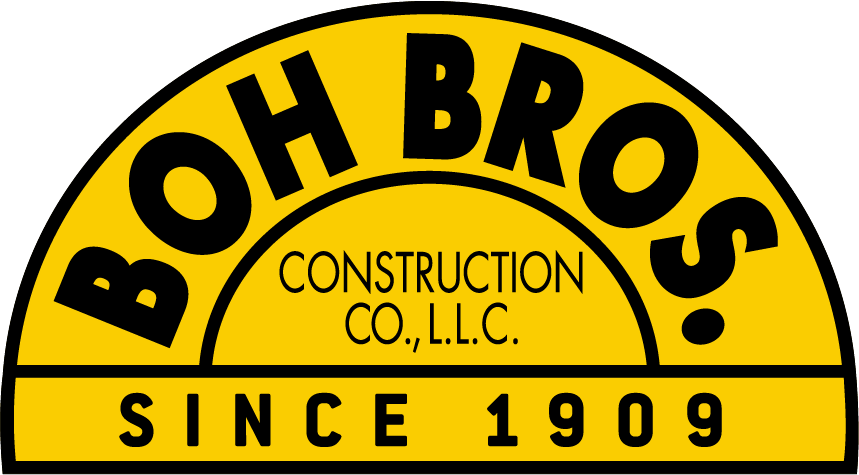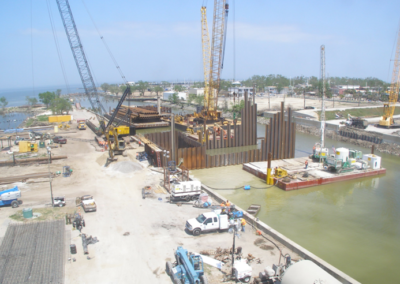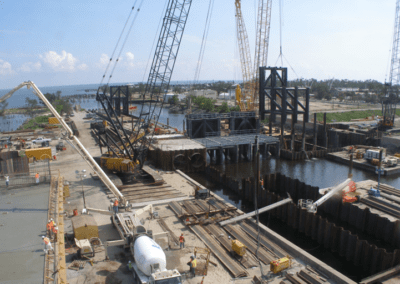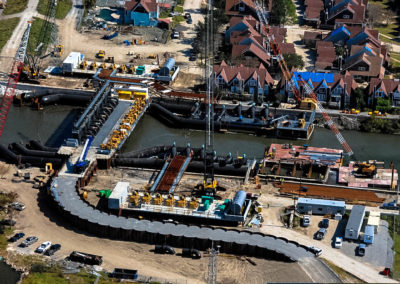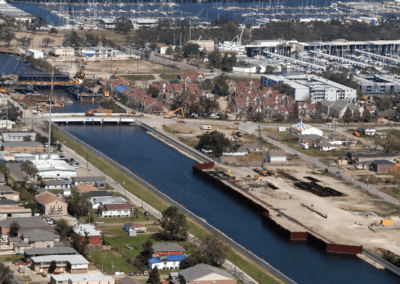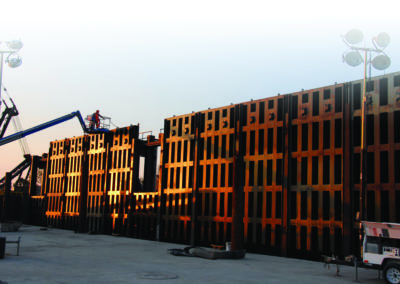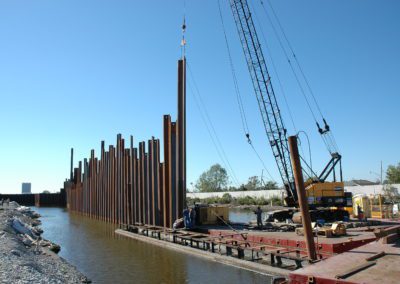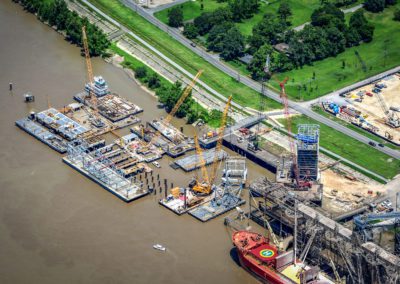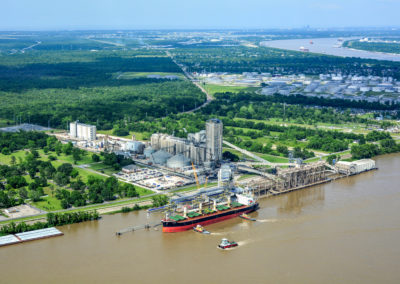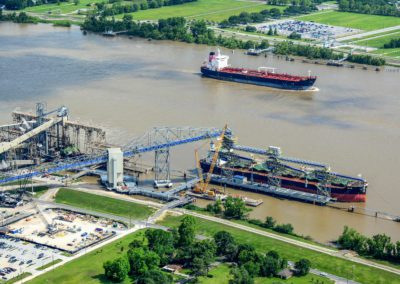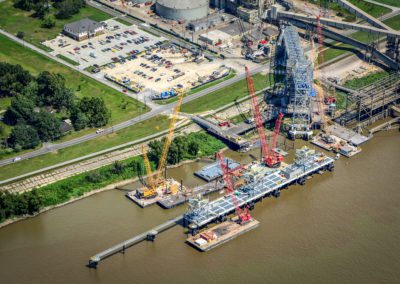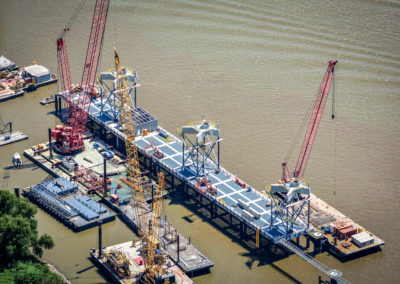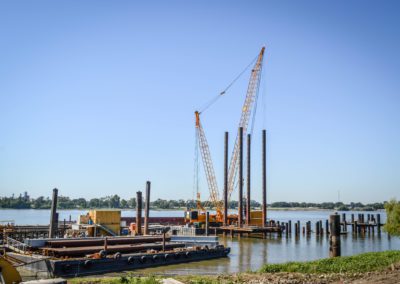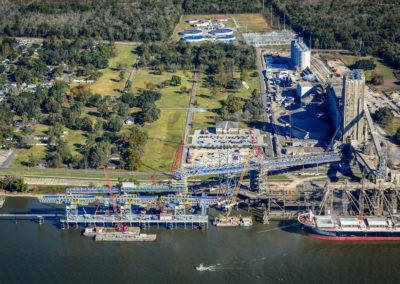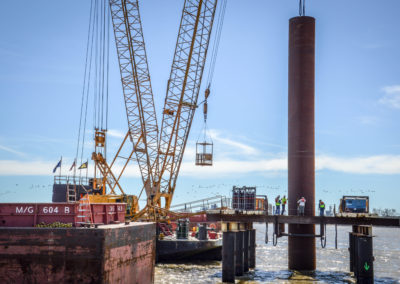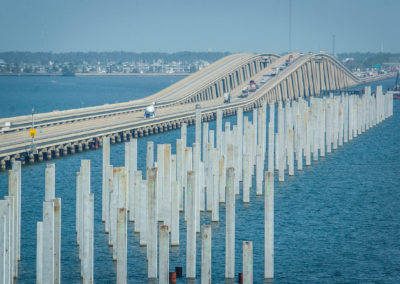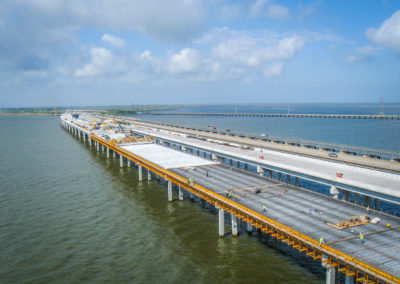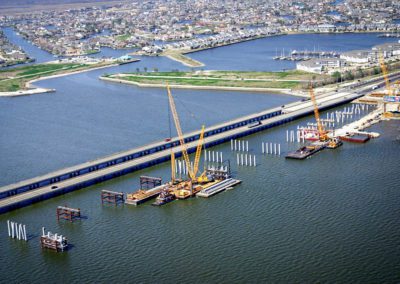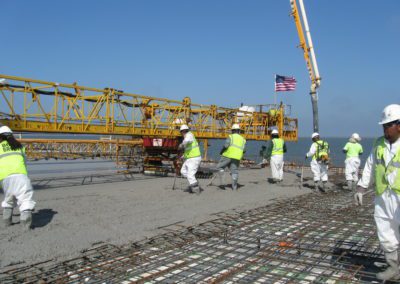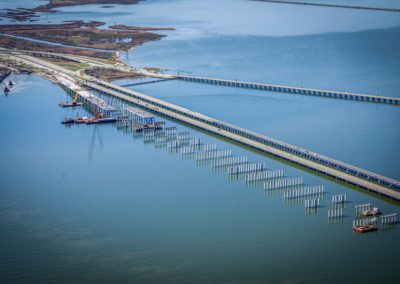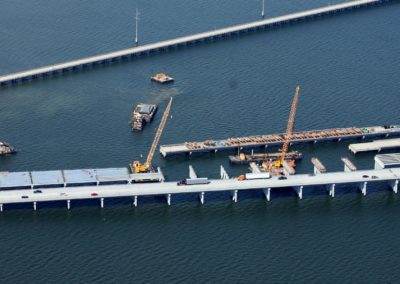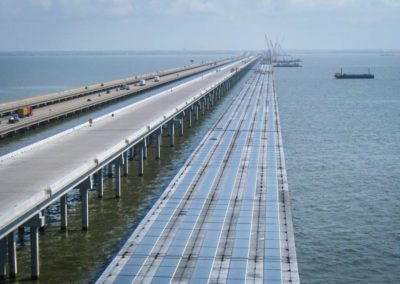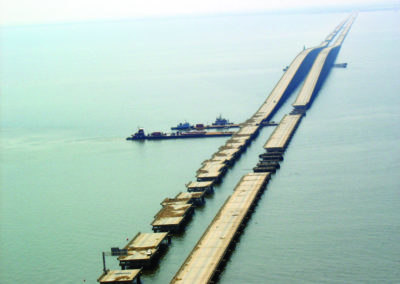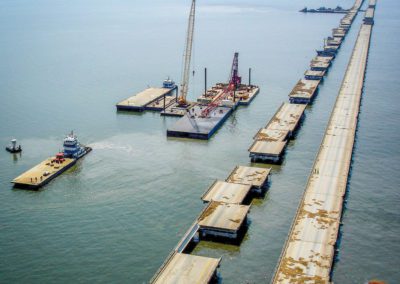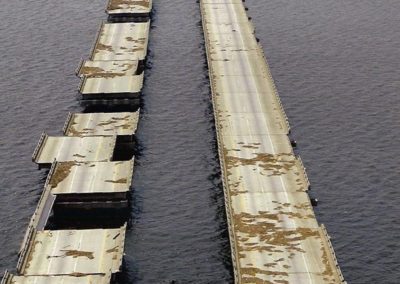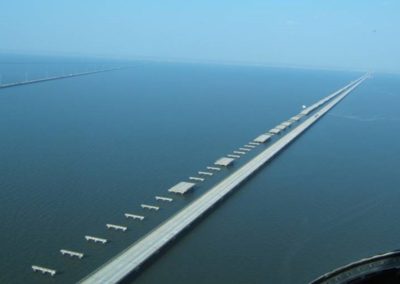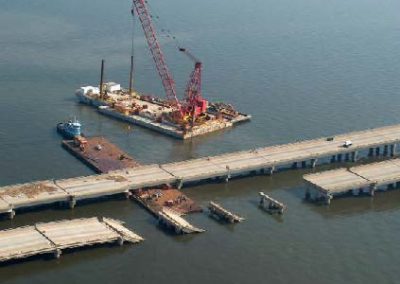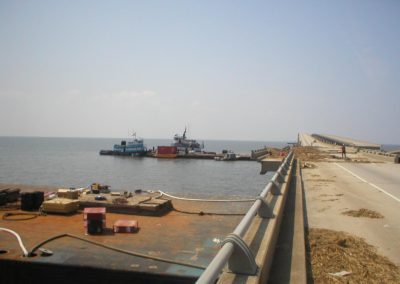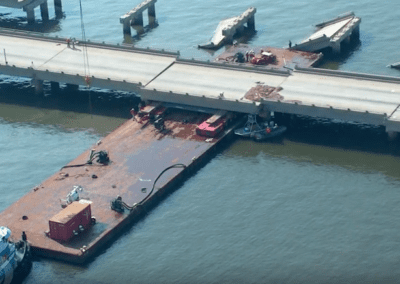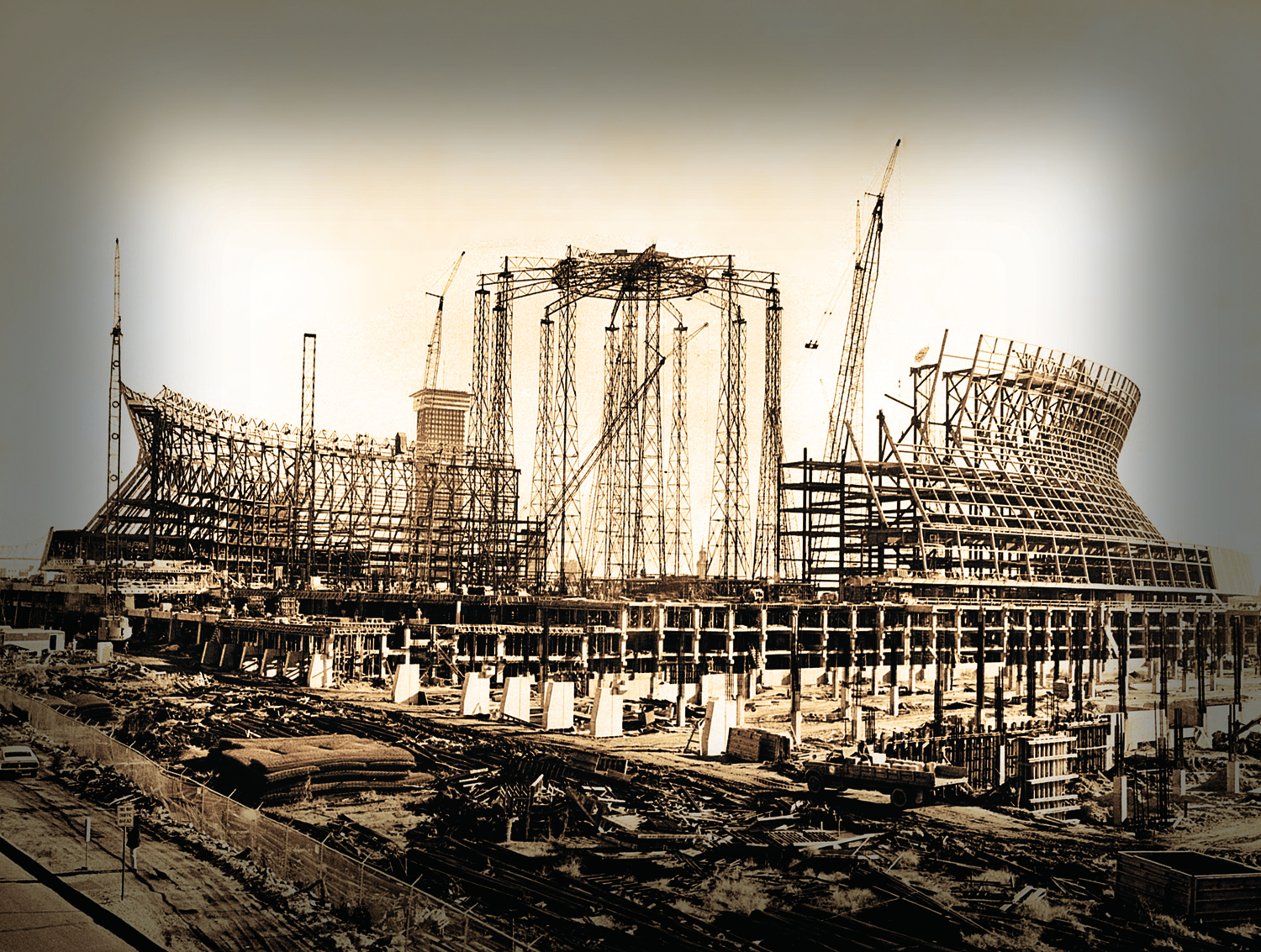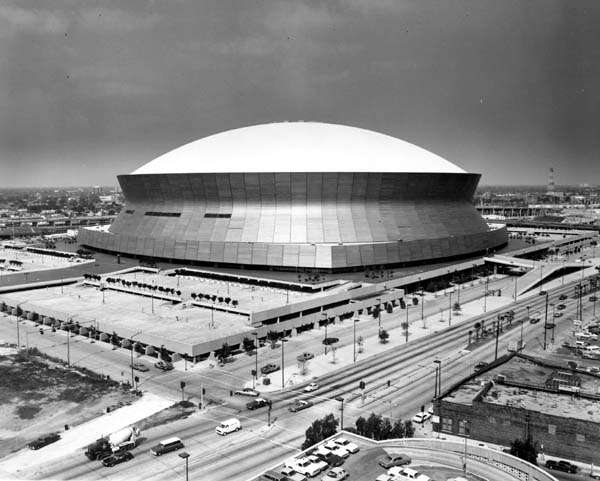Signature Projects
Boh Bros has been in buisness for over 110 years, completing hundreds of projects. Our signature projects stand out among the rest.
17th Street Canal Interim Closure Structure
Boh Bros. was hired by the U.S. Army Corps. of Engineers to build a floodgate structure for the 17th Street Canal in New Orleans, LA. The structure consists of eleven individual flat gates weighing 11 tons each mounted on four 45-foot tall steel jackets weighing 70 tons each. A deck was also constructed for the crane that opens and closes the gates.
Boh was able to fabricate the jacket structures that held the gates at the company’s New Orleans East Fabrication Yard. Services also included building a roadway and ramp constructed of interlocking cells of sheet piling that also acts as a floodwall to the site. Boh was able to complete these signature projects in just five months.
Boh Bros. was hired by the U.S. Army Corps. of Engineers to build a floodgate structure for the 17th Street Canal in New Orleans, LA. The structure consists of eleven individual flat gates weighing 11 tons each mounted on four 45-foot tall steel jackets weighing 70 tons each. A deck was also constructed for the crane that opens and closes the gates.
Boh was able to fabricate the jacket structures that held the gates at the company’s New Orleans East Fabrication Yard. Services also included building a roadway and ramp constructed of interlocking cells of sheet piling that also acts as a floodwall to the site. Boh was able to complete these signature projects in just five months.
Bunge North America Shiploading and Dock Facility
For nearly 60 years, Bunge has handled an assortment of agricultural products from its export terminal along the Mississippi River in Destrehan. It’s one of five such ports in North America that the company uses to export soybeans, corn, wheat and sorghum to customers around the globe.
As the Destrehan facility’s conveyor system approached the end of its service life, Bunge began designing a replacement that would not only allow it to continue operating, but do so more efficiently and productively. Once Boh Bros. was awarded the project in 2015, the design and fabrication of the trestle system was already complete, and there were only 20 months remaining until the deadline for commissioning and startup. Within days of the contract award, Boh mobilized its crews and moved into an existing trailer complex provided by Bunge immediately.
Boh’s first point of attack was the conveyor system’s structural steel drive tower, which would become the nerve center of the entire project as it houses the compressor room, main electrical room, switch gear for incoming power and main conveyor drive motors. Boh drove 16 steel pipe piles as support, measuring 48 and 60 inches in diameter and 175 feet long, followed by a large, elevated concrete platform.
To complement the new conveyor system, Boh constructed a 468-foot-long by 53-foot-wide steel pipe pile-supported, reinforced concrete dock about 200 feet from shore. Arranged as a grid, transverse concrete beams connect the dock’s multiple concrete bents, and heavy duty grating provides the dock surface. Additionally, three 84-inch-diameter monopile mooring dolphins and six 96-inch-diameter monopile breasting dolphins, equipped with high capacity bollards and fender systems, offer support for the massive ships that dock there. Boh also had to work under active ship traffic, as Bunge’s existing ship loading system remained in operation.
Now fully operational, the new conveyor system replaces the existing system, improving Bunge’s efficiencies.
For nearly 60 years, Bunge has handled an assortment of agricultural products from its export terminal along the Mississippi River in Destrehan. It’s one of five such ports in North America that the company uses to export soybeans, corn, wheat and sorghum to customers around the globe.
As the Destrehan facility’s conveyor system approached the end of its service life, Bunge began designing a replacement that would not only allow it to continue operating, but do so more efficiently and productively. Once Boh Bros. was awarded the project in 2015, the design and fabrication of the trestle system was already complete, and there were only 20 months remaining until the deadline for commissioning and startup. Within days of the contract award, Boh mobilized its crews and moved into an existing trailer complex provided by Bunge immediately.
Boh’s first point of attack was the conveyor system’s structural steel drive tower, which would become the nerve center of the entire project as it houses the compressor room, main electrical room, switch gear for incoming power and main conveyor drive motors. Boh drove 16 steel pipe piles as support, measuring 48 and 60 inches in diameter and 175 feet long, followed by a large, elevated concrete platform.
To complement the new conveyor system, Boh constructed a 468-foot-long by 53-foot-wide steel pipe pile-supported, reinforced concrete dock about 200 feet from shore. Arranged as a grid, transverse concrete beams connect the dock’s multiple concrete bents, and heavy duty grating provides the dock surface. Additionally, three 84-inch-diameter monopile mooring dolphins and six 96-inch-diameter monopile breasting dolphins, equipped with high capacity bollards and fender systems, offer support for the massive ships that dock there. Boh also had to work under active ship traffic, as Bunge’s existing ship loading system remained in operation.
Now fully operational, the new conveyor system replaces the existing system, improving Bunge’s efficiencies.
1-10 Twin Spans
Replacement Project
To replace the important I-10 artery, the Federal Highway Administration funded construction of a 100-year, more hurricane-resilient bridge.
At 30-ft.-high, the deck of the new bridge is 21 ft. higher than the original. Each of the new spans is 60 ft. wide, allowing for three lanes of traffic with a shoulder on either side. The old spans were 28 ft. wide. The new bridge meets AASHTO’s ship impact standards by incorporating larger foundations, more redundant members (pilings), and more reinforcement to engage the piles with the caps, and make them more resilient to lateral impact. The bridge was built with high-performance, high-strength concrete that is more resistant to saltwater corrosion than conventional concrete. Lower-level connections between super- and sub-structure are designed to resist uplift forces caused by waves. Slab span decks are connected by means of dowels that were placed at angles to the cap and cast into both the cap and the deck. Concrete diaphragms are tied into the caps with reinforcing steel to secure the Type III girders against uplift. Shear keys were added to restrain the girders against lateral displacement.
Almost a year after Hurricane Katrina had damaged the old bridges, Boh received the notice to proceed on a $379 million contract to construct the 4.5-mile long, low-level portion of the new Twin Spans. The contract was the largest in the company’s history. At the time, it was also the largest letting ever made by the LA DOTD.
In construction of the new Twin Spans, Boh managed to beat every deadline, just as the company did on the emergency repairs of the old bridge. The first new span opened to eastbound traffic July 9, 2009, three months ahead of schedule. Within a week of the ceremony, all six lanes of the bridge were opened to traffic, six months earlier than Boh’s June 2, 2012 scheduled contract completion date. The efficiency and dedication lands this project a spot as one of our signature projects.
I-10 Twin Spans Emergency Repair after Hurricane Katrina
When Hurricane Katrina made landfall in south Louisiana Aug. 29, 2005, the storm delivered a 30-ft. surge across Lake Pontchartrain that tore apart the 1960s-constructed bridge. The uplift knocked the decks off 58 spans and misaligned 438 others.
The damage brought east/west commerce in and out of New Orleans to a screeching halt and hindered recovery efforts there. Average daily traffic at the time was more than 55,000 vehicles, and roughly 25 percent of those were trucks. Not having the bridge operational posed a public safety hazard, as it removed a key evacuation route in the event of other storms.
On September 12, Boh Bros. won a $30.9 million contract from the DOTD to perform emergency repairs on the Twin Spans. Boh worked around the clock with DOTD bridge designers, subcontractors, and Volkert, Inc., which performed construction engineering and inspection services for the DOTD. The team managed to open the eastbound span to two-way traffic in only 28 days, 17 days ahead of schedule.
By January 6, 2006, Boh had realigned 265 decks on the westbound span, and filled in 26 gaps with prefabricated Acrow bridge sections, allowing the DOTD to open that span to traffic eight days earlier than scheduled.
When Hurricane Katrina made landfall in south Louisiana Aug. 29, 2005, the storm delivered a 30-ft. surge across Lake Pontchartrain that tore apart the 1960s-constructed bridge. The uplift knocked the decks off 58 spans and misaligned 438 others.
The damage brought east/west commerce in and out of New Orleans to a screeching halt and hindered recovery efforts there. Average daily traffic at the time was more than 55,000 vehicles, and roughly 25 percent of those were trucks. Not having the bridge operational posed a public safety hazard, as it removed a key evacuation route in the event of other storms.
On September 12, Boh Bros. won a $30.9 million contract from the DOTD to perform emergency repairs on the Twin Spans. Boh worked around the clock with DOTD bridge designers, subcontractors, and Volkert, Inc., which performed construction engineering and inspection services for the DOTD. The team managed to open the eastbound span to two-way traffic in only 28 days, 17 days ahead of schedule.
By January 6, 2006, Boh had realigned 265 decks on the westbound span, and filled in 26 gaps with prefabricated Acrow bridge sections, allowing the DOTD to open that span to traffic eight days earlier than scheduled.
Superdome Piles
In 1971, Boh Bros. drove the test piles for the New Orleans Superdome, and in 1972 drove the piles upon which the Superdome stands to this day. Boh drove approximately 2,200 pre-stressed concrete piles measuring 170 feet in length, and 2,300 treated timber piles measuring 55 feet in length.
Following the addition of the roof, Boh returned in 1973 to drive 960 composite piles measuring 60 feet in length under the current playing surface.
